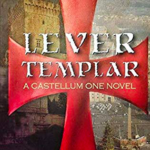
This historical-action-espionage novel (as strange as that combo may sound) asks the question: just what was it that allowed the Knights Templar to exert influence in or over the Roman Catholic church during the 12th/13th centuries? And what if that object still posed a threat to Christian belief in modern times? And can we build a novel around such a potentially
This is the basis for Matt Gianni’s Lever Templar, a novel that skilfully weaves a historical action tale set in the early 14th century with a contemporary thriller. Revolving around the demise of the Knights Templar by Philip IV and combining the machinations of the French Pope Clement V, Gianni draws together a vast cast of characters and relies on blending a variety of real and supposed personages. The reader is teased by some references demanding further research and also rewarded by illuminating lesser-known aspects of the fall of the Templar order.
The initial cast of characters seems rather daunting and initially, the short chapters flipping back and forth between multiple settings in historical and contemporary time is slightly confusing. However, as the novel plays out and the main protagonists are identified and fleshed out the narrative gels very nicely. The action is fast-passed and well balanced. The twists and the short chapters make this a gripping read. Likewise, the shorter chapters allow for stepping away and returning right back to the action as suits the reader.
Some aspects of the constructed narrative stretch credulity at times. I am not entirely convinced of the ability of ‘the Alumni’ being able to exist and quietly build and suddenly overwhelm Syria (a nation-state in civil war or otherwise) or of Iran that had allowed the group to foment. Likewise, the ability (or even desire) of the US or the UK, to intervene quickly and decisively or to still serve as the world’s policeman seems slightly dated.
The novel is aided by superb maps and by a skilful blend of background information about the Templars and the historical shape of the late 13th and early 14th centuries. Combining this with a shadowy terrorist group that feel equally sure that the same object that so threatened the Catholic church in history could similarly sow similar chaos in the modern day.
This novel reads in a not dissimilar way to Geraldine Brooks’ People of the Book or Charlie Lovett’s Lost Book of the Grail. However, unlike these, this initial and debut novel sets up and promises a follow series ‘Castellum One’ – the name given to the unique cast of characters assembled in this novel to investigate and combat the forces of evil in modern time. I look forward to the next novel and highly commend this first one for readers appreciating a historical novel, alternate historical novel or simply those appreciating a rich and well-constructed action suspense novel. You’ll appreciate the well-developed characters and maybe even learn a bit about the history played with to construct the story. This would undoubtedly appeal to fans of Dan Brown’s novels.
